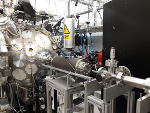LhARA ionacoustic dose profiling meeting: 21Jul21; 09:00 BST
Notes
- Introduction, notes and actions of previous meeting: KL/All
- KL Set up meeting with Colin Whyte
- Stands
- JG: Summarise state of the art in literature to get a baseline for what our proof-of-principle system needs to do
- Done. Email circulated, and appended to these notes.
- KL/AMRL: Agree beam parameters for simulation and generate relevant beams for input to the acoustic simulation Done
- KL/AMRL: Obtain from HTL the Bragg-peak calculator, test and send to JG.
- Done.
- KL Set up meeting with Colin Whyte
- Progress updates : All
- We discussed organisation for proposal (slides form KL and JM presented at Tuesday's LhARA meeting).
- Anthea summarised the evolution of the FWHM of the Bragg peak with energy. We discussed the energy variation and detection strategies.
- We discussed the normalisation to Pascals in the acoustic signal and image reconstruction in MatLab.
- Next steps--discussion: All
- AOB: All
From Jamie:
Please find attached a short document containing what I said I’d share after the meeting. Briefly, these are:
- Summaries of 2 studies in literature. I used ones I’d looked at previously and noted values from. These might not be the most representative. I’ll note my choice of high energy study leaves something to be desired because their signal mostly came from the cylindrical incident beam (and not obvious what came from the BP). Still, hopefully useful for discussion.
- A note on stress confinement.
- A note on acoustic frequencies.
I omitted my graph of minimum detectable pressures of detectors because in the end this did not feel all that relevant. This was because this graph was limited to higher frequency detectors whereas we are likely going to be most interested in low frequency detectors. I think the examples give some evidence that clinical energies, as well as more relevant, should provide detectable (low frequency) signals. However, detectability is more readily guaranteed at lower energies. Perhaps the more useful message is clarifying the links between proton energy, BP dimensions, pulse lengths, and frequency content.
Attachments (2)
- Ionoacoustics-project-notes.pdf (2.2 MB ) - added by 4 years ago.
- bragg_width.png (45.1 KB ) - added by 4 years ago.
Download all attachments as: .zip
